It’s a common misconception that Indonesian recipes are challenging to follow, but it’s the wrong approach.
We have whipped up a combination of Indonesian recipes that help you enjoy the most authentic flavors without making it hard for you.
We understand that finding the ingredients for Indonesian recipes is difficult, but all these recipes are easy to prepare with regular ingredients.
So, ranging from rice dishes to stews and pancakes, our recipe has something for everyone because we want everyone to enjoy the delectable flavors.
You Might Also Be Interested in:
Nasi Goreng
The iconic Indonesian dish nasi goreng has spread throughout the world. Cooked rice is stir fried with a variety of fragrant spices.
These spices and ingredients include garlic, shallots, and chili paste, because they help create this savory and filling dish.
The end result is a delectable combination of flavors and textures that has made Nasi Goreng a popular comfort food.
Nasi Goreng, a meal that is a mainstay in Indonesian cooking and shows the nation’s rich culinary tradition, can be eaten both on its own and as a side dish.

Satay Ayam
Over an open flame, marinated chicken pieces are skewered and grilled, producing tender, juicy meat with a light smokey flavor.
A blend of turmeric, lemongrass, garlic, and other spices is used to marinate the chicken, giving it a pleasant aroma and a mildly sweet and acidic flavor.
Rice cakes, cucumber slices, and peanut sauce are frequently served alongside satay ayam, giving the ideal balance of tastes and textures.
It is a well liked meal that displays the diverse culinary history of Indonesia and is perfect for parties, barbecues, and quick snacks.
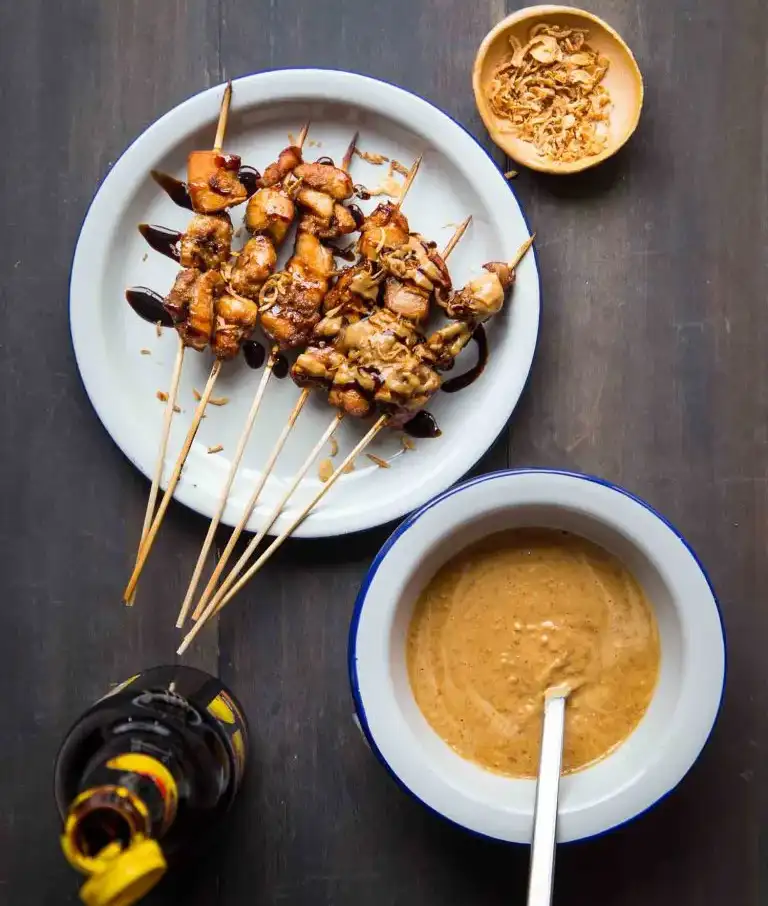
Gado Gado
A colorful and energizing Indonesian salad called gado gado nicely captures the diversity of the food in that nation.
It is made up of a vibrant variety of vegetables, including cabbage, potatoes, green beans, and bean sprouts, along with tofu, tempeh, and hard boiled eggs.
The decadent peanut sauce that goes with it is what really makes this dish stand out.
The sauce is a harmonic fusion of sweet, acidic, and mildly spicy flavors that is produced from ground peanuts, palm sugar, tamarind, garlic, and chile.

Soto Ayam
The popular chicken soup Soto Ayam is regarded as a comfort food main stay in Indonesia.
In a fragrant broth, chicken, lemongrass, galangal, and a mixture of spices are simmered to create this fragrant and savory soup.
Then, things including hard boiled eggs, bean sprouts, shredded chicken and fried shallots are added to the soup.
A warming and filling dish that warms the body and the soul is produced by the marriage of soft chicken, fragrant broth, and the assortment of garnishes.
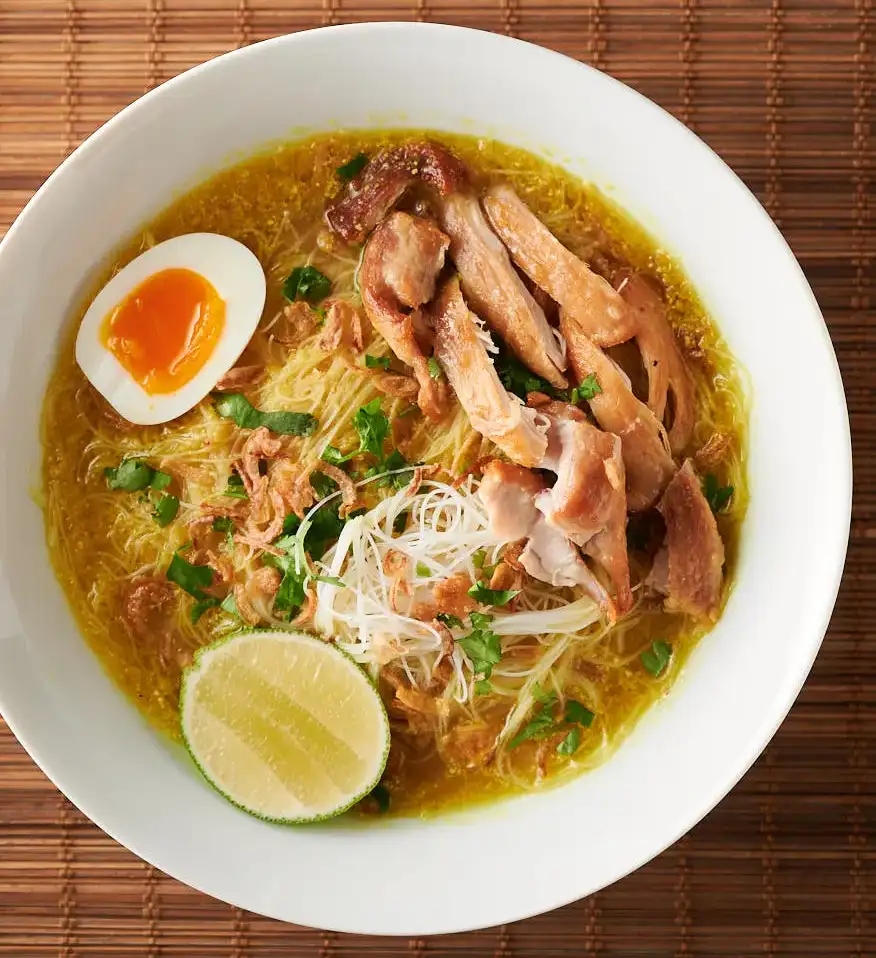
Rendang
Rendang is a traditional Indonesian meal that has won praise for its nuanced flavors on a global scale.
Rendang is a slow cooked beef stew that has its roots in the Minangkabau culture of West Sumatra and is made for festive events and special gatherings.
Beef is simmered in a flavorful mixture of coconut milk and a variety of aromatic roots and leaves, as well as ginger, galangal, and lemongrass.
The flavors infiltrate the beef as the liquid evaporates, creating delicate, luscious meat that is filled with a symphony of spices.
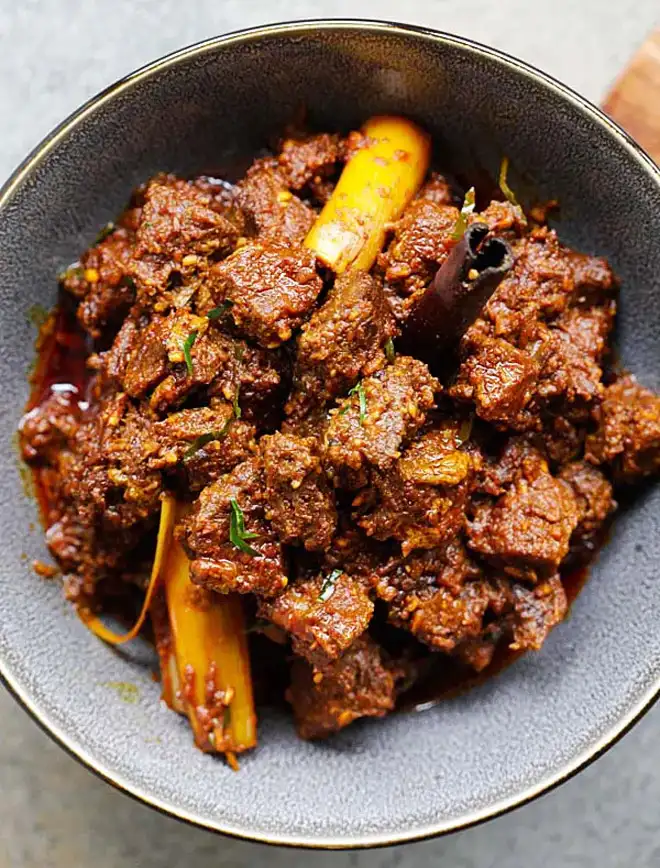
Sate Padang
The Padang region of West Sumatra, Indonesia, is where Sate Padang, a distinctive and delectable version of satay, first appeared.
The meat, typically beef or offal, is marinated in a mixture of spices that may include turmeric, coriander, garlic, and ginger.
This dish is distinguished by the rich and sour yellow sauce known as “kuahgulai.” It is then expertly skewered and cooked, producing soft and yummy meat.
The thick and flavorful gulai sauce, which is the star of Sate Padang, is created from a blend of spices, coconut milk, and beef broth.
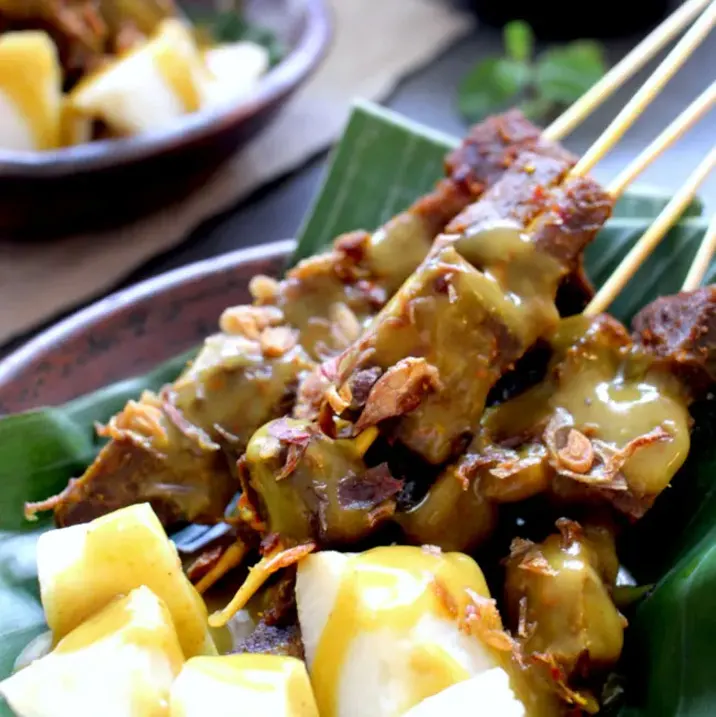
Ayam Betutu
Traditional Balinese food called “Ayam Betutu” is renowned for its potent tastes and fragrant spices.
Whole chickens are marinated in a concoction of Balinese seasonings, which frequently includes shallots, garlic, ginger, turmeric, chili, and galangal.
The chicken is then firmly wrapped in banana leaves and slowly roasted or grilled until it is very soft and has absorbed the flavorful spice blend.
The outcome is a dish of chicken that perfectly captures the flavor and scent of Balinese cooking.
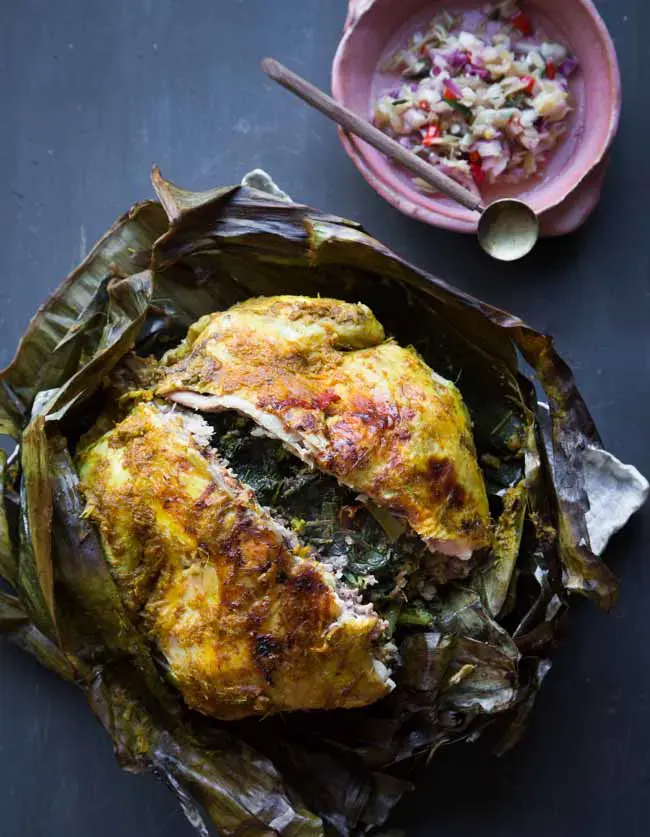
Nasi Uduk
A popular breakfast or lunch option in Indonesia is nasi uduk, a fragrant and savory rice dish.
It is prepared by simmering rice in coconut milk with flavorful ingredients, such as lemongrass, pandan leaves, and bay leaves, to give the rice an aroma.
Various side dishes, including fried chicken, crispy tempeh, fried anchovies, and sliced cucumber, are frequently served with nasi uduk.
The mix of fragrant rice and a variety of tasty side dishes produces a comfortable and cozy supper that Indonesians like.
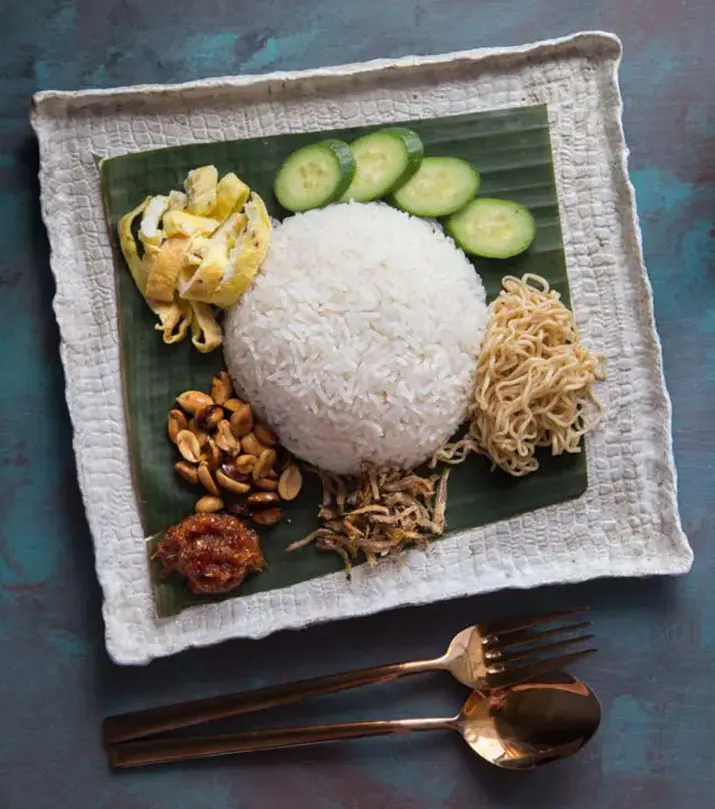
Mie Goreng
Mie Goreng is a well known stir fried noodle dish from Indonesia that is adored for its straightforwardness and robust tastes.
Although varieties with rice noodles or egg noodles are also available, yellow noodles are the most common type used.
To intensify the flavors, a sauce mixture that may contain kecapmanis (sweet soy sauce), oyster sauce, and sambal is added.
The noodles are precisely cooked and flavored with the delectable ingredients, creating a lovely combination of textures and flavors.
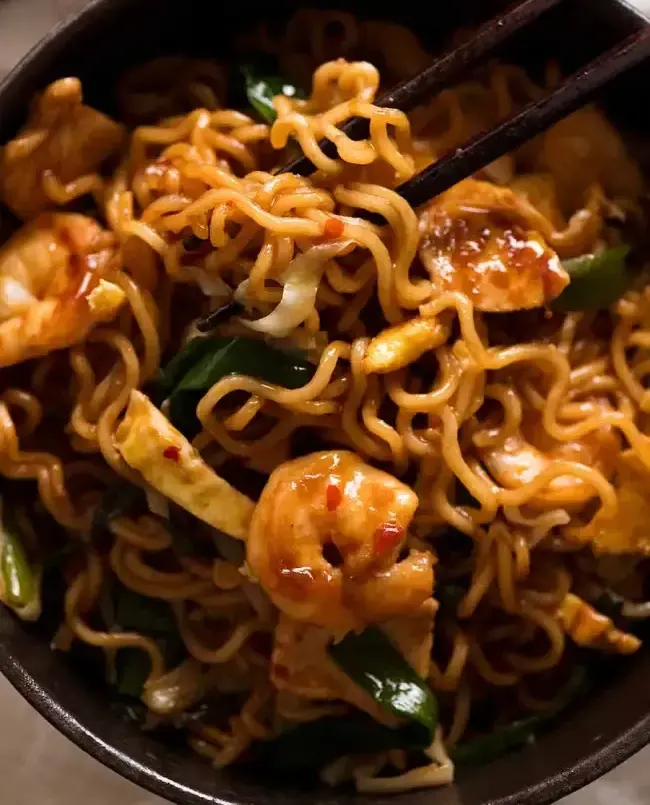
Sop Buntut
The major component in Sop Buntut, a rich and soothing Indonesian soup, is tender oxtail.
In order to make the oxtail soft and tasty, it is carefully cooked with flavorful herbs and spices including garlic, shallots, ginger, and nutmeg.
The soup is frequently enhanced with vegetables including tomatoes, potatoes, and carrots, which give the dish flavor and color.
The resulting broth has a soothing meaty flavor and is rich, fragrant, with just a touch of sweetness.
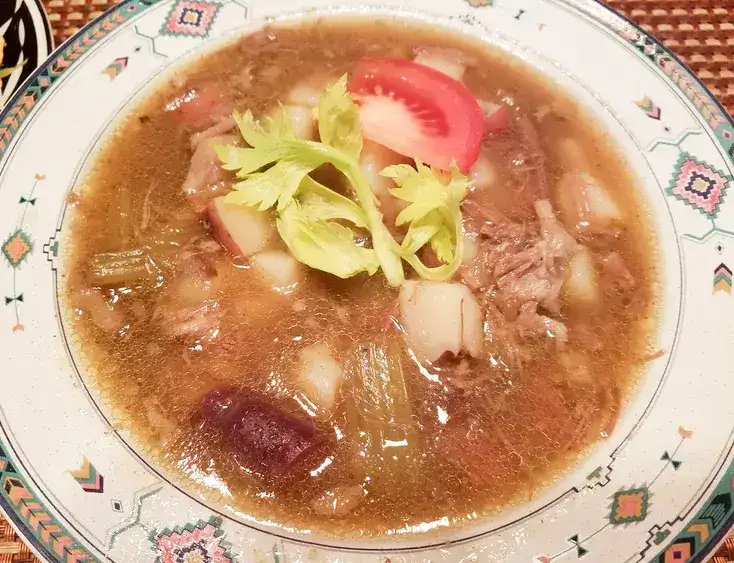
Pempek
A mixture of ground fish, typically mackerel or tapioca flour, and seasonings like garlic, salt, and sugar are used to make this distinctive and delectable delicacy.
The mixture is formed into different shapes, like long rolls or dumplings, and deep fried till golden brown and crispy.
The customary accompaniment for pempek is “cuko,” a tangy, sweet, vinegar based dipping sauce consisting of palm sugar, vinegar, chili, and garlic.
The rich cuko sauce and the salty fishcake combine to produce a lovely textural and flavor contrast.
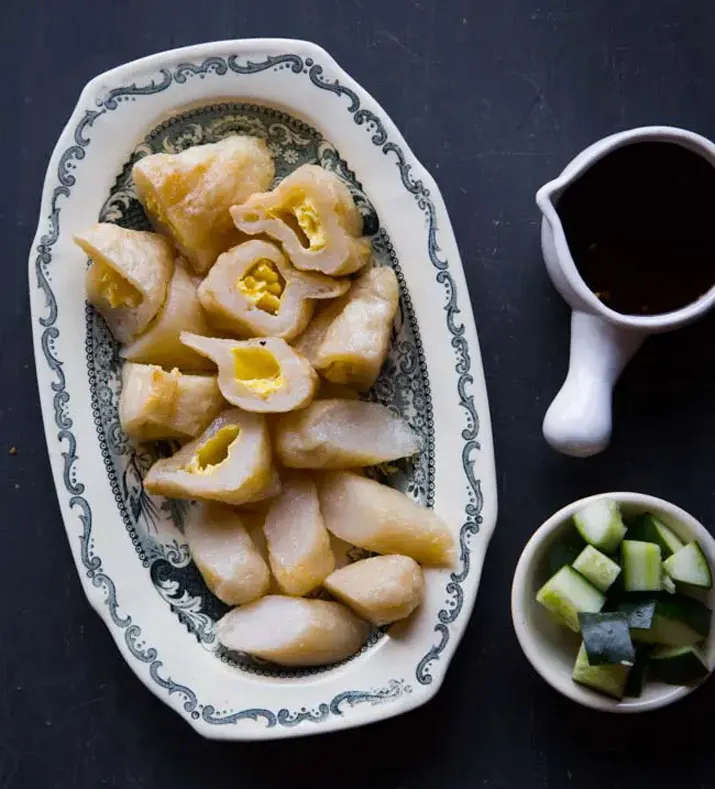
Sambal Matah
The traditional Indonesian condiment known as sambal matah comes from Bali.
It is a raw sambal made of coconut oil, lime juice, and finely sliced shallots, lemongrass, chili peppers, and kaffir lime leaves.
The end result is a colorful, fragrant sambal with a crisp citrus flavor and a touch of heat.
In addition to grilled meats, fish, or rice meals, sambal matah is frequently offered as a side dish.
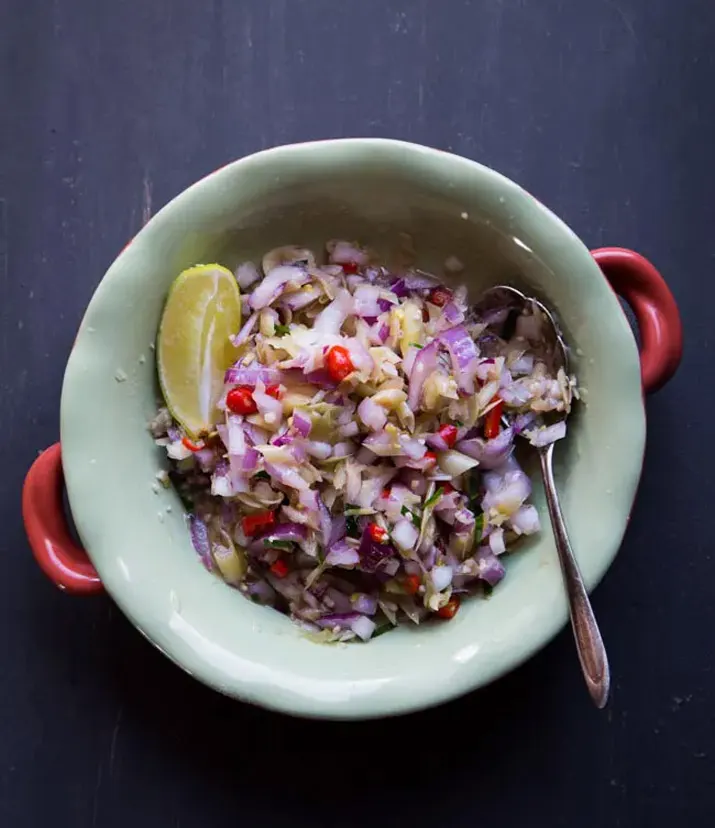
Sambal Terasi
Throughout the archipelago, sambal terasi, a traditional Indonesian chili sauce, is extensively consumed.
Red chili peppers, garlic, shallots, and belacan (shrimp paste) form the foundation of this dish.
After mixing into a paste, the ingredients are sauteed until aromatic. The resulting sambal has a rich, savory flavor with the balance of umami & spice.
Sambal Terasi is a multipurpose condiment that can be added to a variety of foods as a marinade, a dip, or a flavoring.
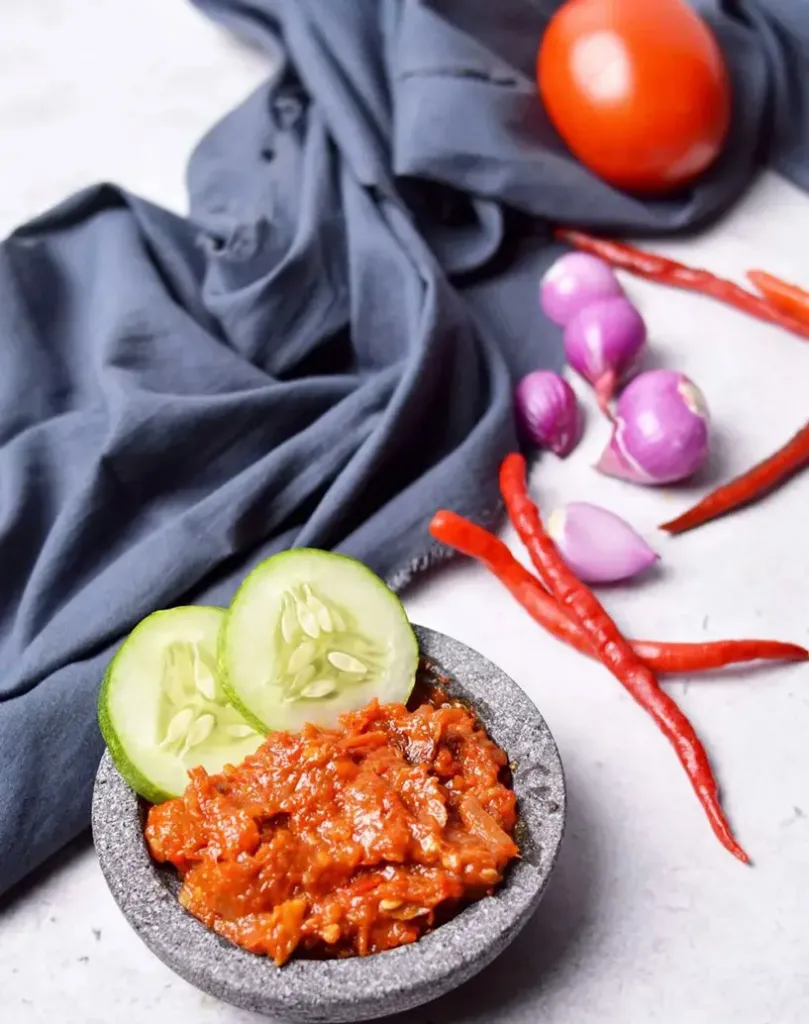
Babi Guling
Famous traditional Balinese meal Babi Guling is a good example of the island’s top notch cuisine.
It is a whole roasted suckling pig that has been marinated in a mixture of herbs, spices, and seasonings.
Typical ingredients include chile, lemongrass, turmeric, garlic, ginger, and ginger.
Slowly roasting the pig over an open flame or in a pit produces crispy, golden skin while maintaining juicy, tender meat.

Bakso
In Indonesia, a dish known as “bakso” is very common. It consists of tasty meatballs served in a hot, savory broth.
The meatballs are produced with a blend of ground beef or chicken, tapioca flour, and seasonings including garlic, salt, and pepper.
Bakso is frequently consumed with a bowl of clear or hazy soup that has been spiced up with herbs, spices, and cattle bones.
Noodles, tofu, crispy wontons, and other toppings such veggies and vegetables are frequently added to it.
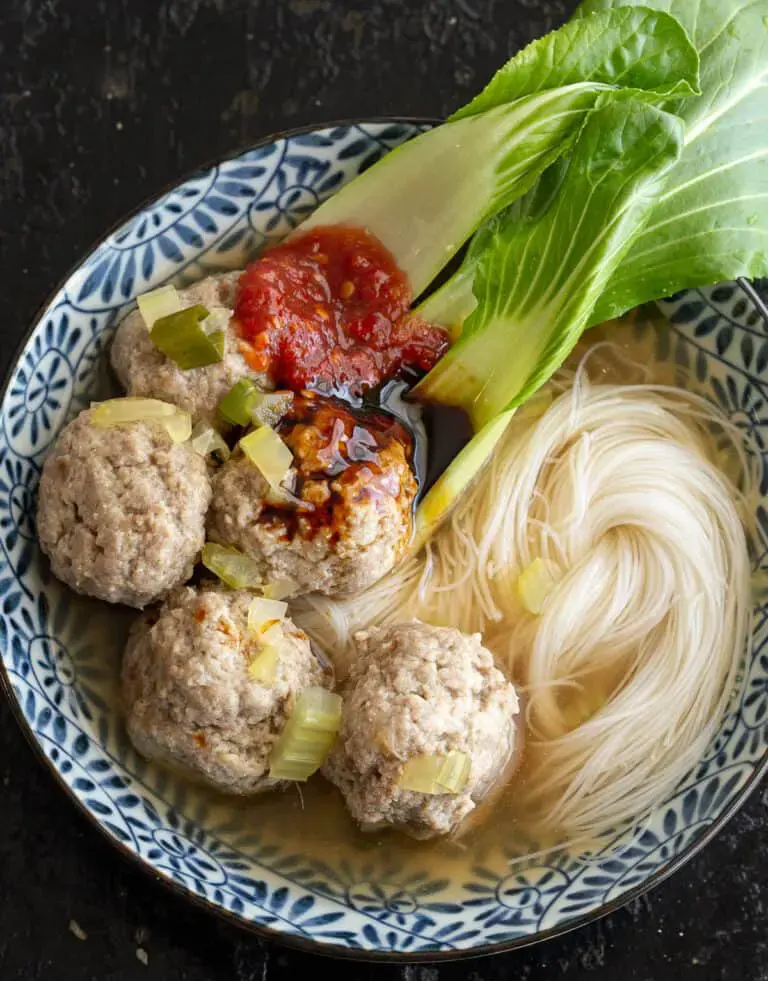
Martabak
Popular Indonesian street cuisine known as martabak can be eaten either sweetly or savory.
The sweet variation, called Martabak Manis, is a rich and decadent dessert loaded with a combination of chocolate, cheese, and condensed milk.
The Martabak Telur, a savory variation, is stuffed with a combination of seasoned ground beef, eggs, and veggies.
After folding, the pancake is fried till golden and crispy. Every taste of martabak is enhanced by the tangy, hot dipping sauce that is frequently given with it.

Nasi Kuning
An Indonesian rice dish known as nasi kuning is frequently served at festive festivities and special occasions.
Due to the golden tint that results from cooking the rice with turmeric and coconut milk, it is known as “yellow rice”.
A variety of aromatic spices, including lemongrass, bay leaves, and kaffir lime leaves, are then used to flavor the rice, giving it a wonderful aroma.
Nasi Kuning is a tasty addition to a number of dishes in addition to being aesthetically pleasing.
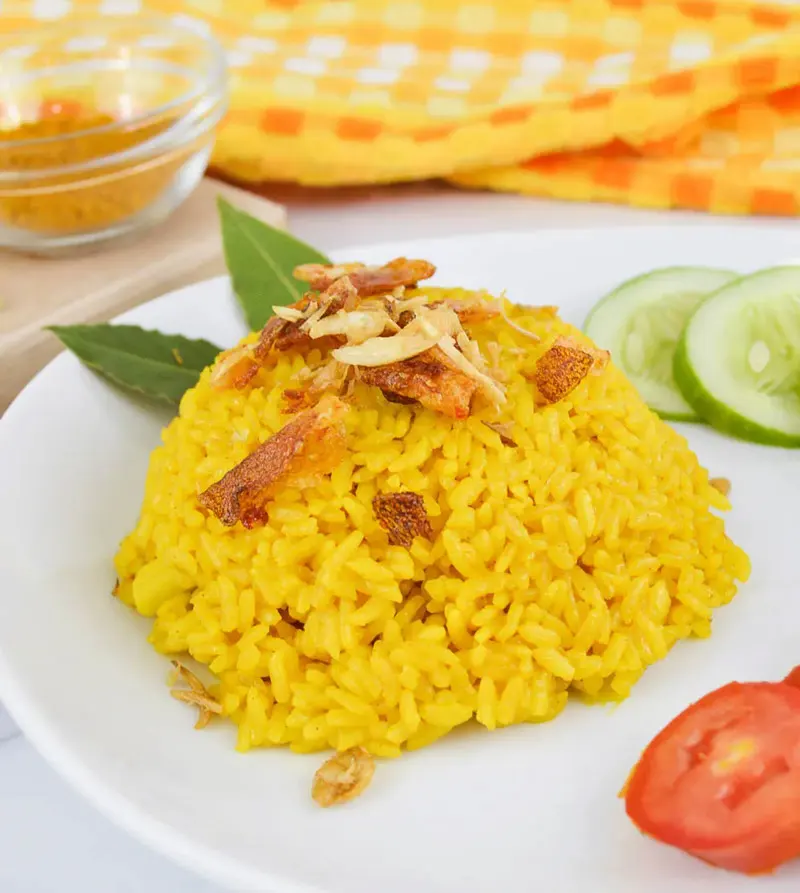
Pepes Ikan
Fish is wrapped in banana leaves for Pepes Ikan, a traditional Indonesian meal that is steamed to produce a flavorful and luscious seafood dish.
The fish, which is typically tilapia or snapper, is marinated in a fragrant blend of herbs and spices that includes chile, ginger, shallots, turmeric, and garlic.
The fish is then steamed until fully cooked while being wrapped in banana leaves, which give the meal a mild flavor.
As a result, the fish is moist and delicate and has a delicious combination of marinade and banana leaf flavors.
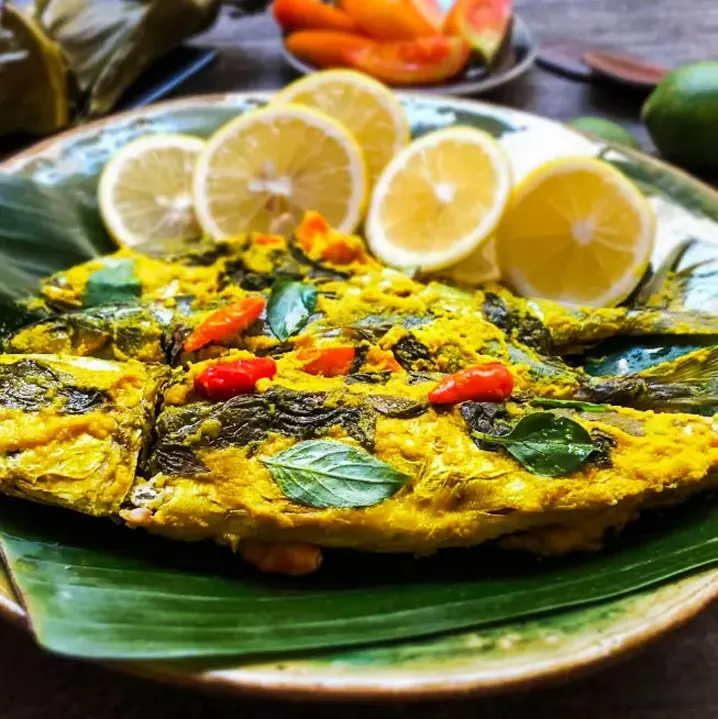
Nasi Padang
Famous food known as nasi padang comes from West Sumatra, Indonesia, namely from the Padang area.
It describes a way of eating where steamed rice is offered with a variety of tasty meals.
The meals frequently feature a variety of spices, including galangal, chili, turmeric, lemongrass, and lemongrass.
Nasi Padang is the showcase for Padang’s distinctive culinary heritage and its capacity to produce a truly unforgettable eating experience.
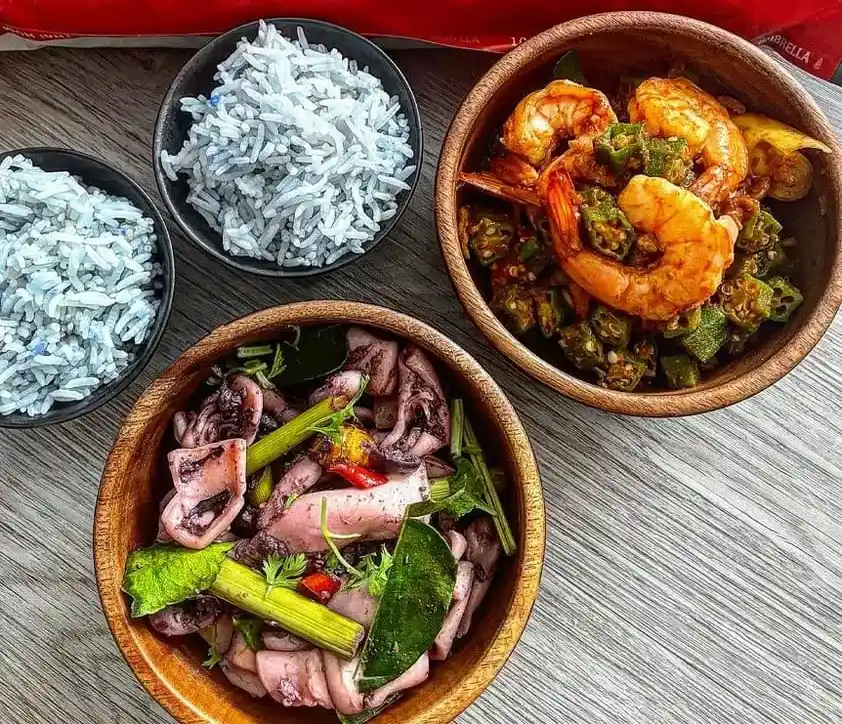
Sayur Asem
A well known Indonesian soup called sayur asem is renowned for its tart and energizing qualities.
A mix of vegetables, including chayote, long beans, maize, tomatoes, and cabbage, are combined in this tamarind based soup.
Along with spices like shallots, garlic, galangal, and bay leaves, the soup is seasoned with tamarind pulp, which gives it a delightfully acidic flavor.
Sayur Asem is frequently appreciated as a warm and light dish that contrasts nicely with other rich Indonesian dishes.

Rawon
Due to the addition of black nuts, also known as keluak, rawon is a traditional beef soup from Java.
A combination of aromatic spices, including shallots, garlic, ginger, galangal, and lemongrass, are simmered with beef to create this delectable soup.
The soup’s main ingredient, black nuts, gives it a distinctive earthy and nutty flavor. Rawon is served with steamed rice, salted duck eggs, and bean sprouts.
A dish that is incredibly satisfying and comforting is produced by the marriage of soft beef, flavorful broth, and a variety of toppings.
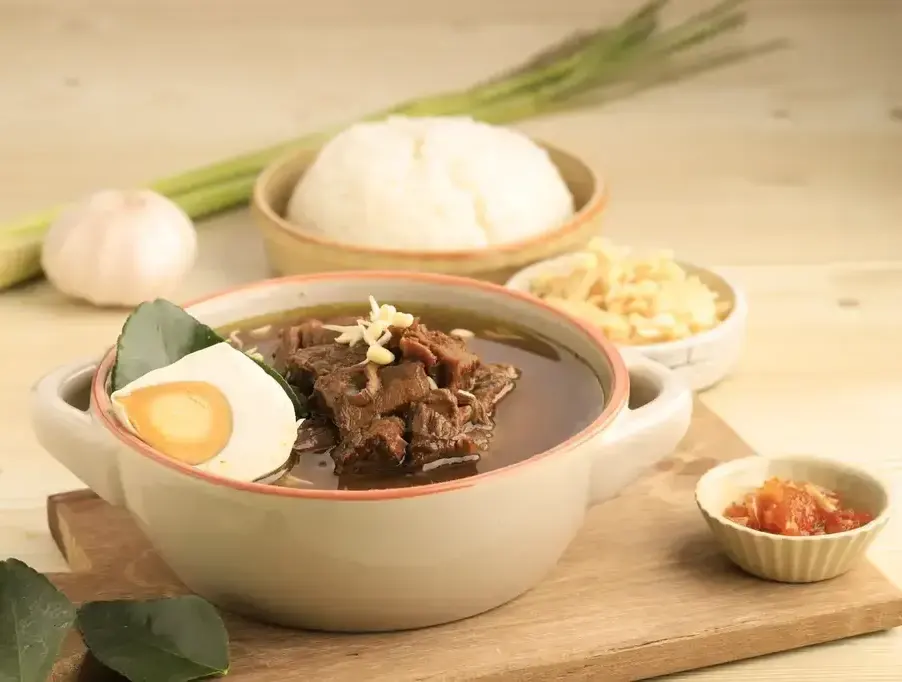
Soto Betawi
The Betawi people of Jakarta, Indonesia, are the creators of the well known beef soup Soto Betawi.
It is a tasty and filling soup made with tender beef and a fragrant broth that is flavored with garlic, shallots, galangal, and lemongrass.
The addition of coconut milk gives the soup a thick, creamy texture and intensifies the tastes.
Slices of meat, fried potatoes, tomatoes, and emping crackers are some of the common toppings for soto betawi.
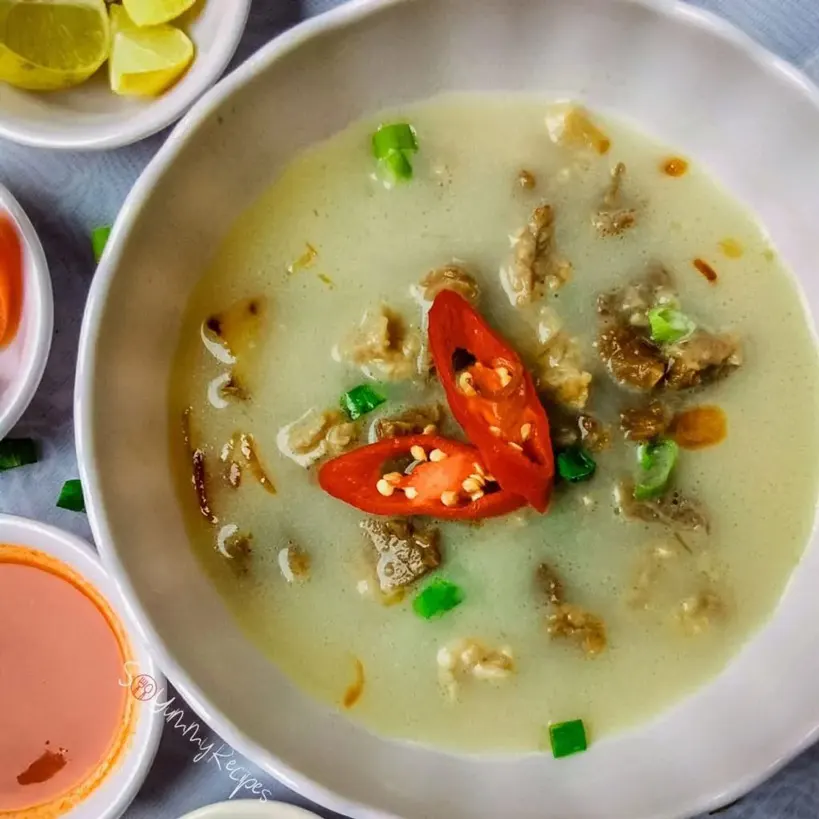
Pindang Ikan
Fish, usually freshwater fish like carp or catfish, are simmered in a mixture of aromatic spices, tamarind, and tomatoes to create this vivid and tangy soup.
As a result, a tasty broth is produced that has a great balance of sourness and heat.
Veggies like mustard greens, mushrooms, and bean sprouts are frequently added to pindang ikan to give the meal more texture and freshness.
Steamed rice, a squeeze of lime juice, and a scattering of chopped herbs are typical accompaniments.
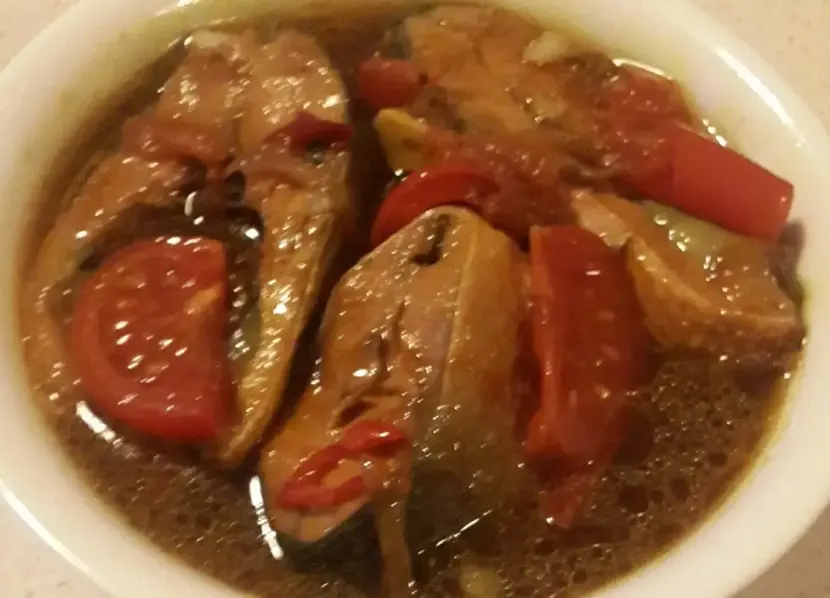
Rujak
Rujak is a unique and delightful fruit salad from Indonesia that blends a range of tropical fruits with a hot and sour sauce.
Ingredients including palm sugar, tamarind, chili, lime juice, and shrimp paste are combined to create the sauce.
Sliced or cubed fruits, such as pineapple, mango, cucumber, jicama, and green apples, are combined with the hot sauce.
Crushed peanuts and fried shallots are frequently used as garnish on rujak to add taste and texture.
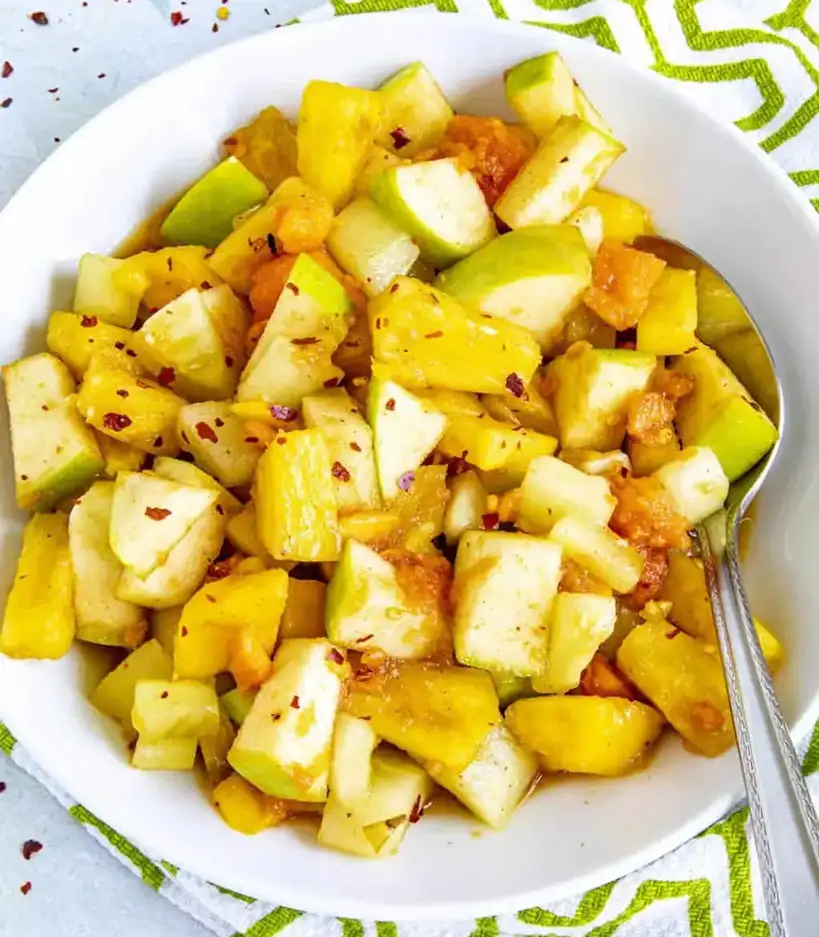
Es Cendol
Popular Indonesian delicacy called Es Cendol is a cold and delicious treat, especially in hot weather.
Cendol, a type of green jelly like rice flour noodle, is used in this dish, which also includes palm sugar syrup, crushed ice, and a sweet coconut milk soup.
Cendol noodles have a green hue and a slightly chewy texture because they are created from a combination of rice flour, pandan juice, and water.
The palm sugar syrup offers a delicious caramel like sweetness, while the sweet coconut milk soup adds a creamy and fragrant flavor.
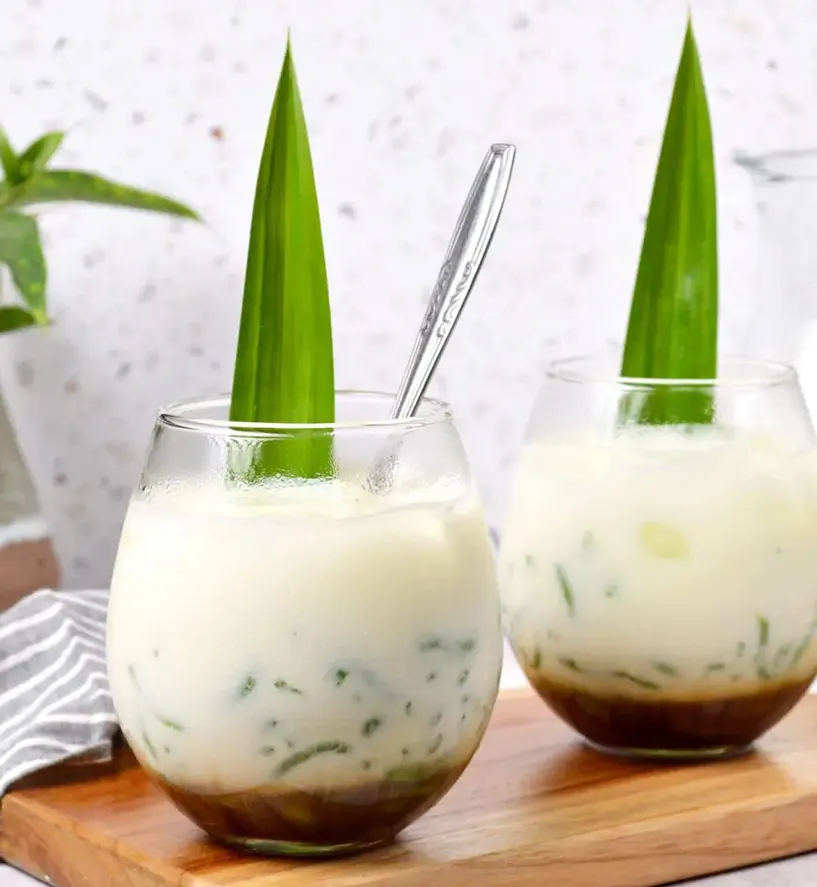
Serabi
The delectable Indonesian pancake known as serabi is frequently eaten for breakfast or as a sweet dessert.
These pancakes have a distinct texture and a light undertone of sweetness thanks to the batter, which is made of rice flour, coconut milk, and palm sugar.
Usually prepared on a traditional clay griddle called a “kuali,” serabi have a slightly crispy exterior and a tender, juicy interior.
They are frequently served with a drizzle of coconut milk and a garnish of sesame seeds or grated coconut.

Klepon
Klepon is a delicious delicacy made out of bite sized balls of glutinous rice that have been covered in grated coconut and are filled with liquid palm sugar.
These vibrantly green balls have a light floral scent and are created from a blend of glutinous rice flour and pandan juice.
Every bite of the balls delivers a rush of sweetness since they are packed with a delicious and sticky palm sugar syrup.
The Klepon are cooked before being rolled in freshly grated coconut, which gives them a different texture and a slight nutty flavor.
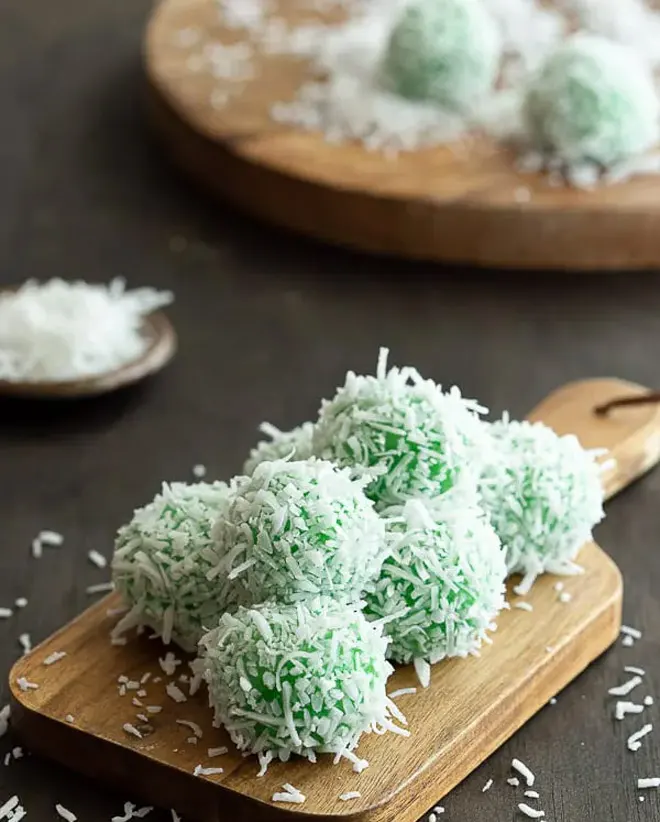
Sambal Goreng Ati
A spicy and flavorful Indonesian meal called sambal goring ati includes stir fried chicken liver in a hot sauce.
Usually, a mixture of shallots, garlic, turmeric, and chile, is used to marinade the chicken liver before it is stir fried with lemongrass and kaffir lime leaves.
The end result is a dish with soft chicken liver that has been flavored with fragrant spices and a spicy chili taste.
In addition to steamed rice, sambal goring ati is frequently included in bigger Indonesian meals.
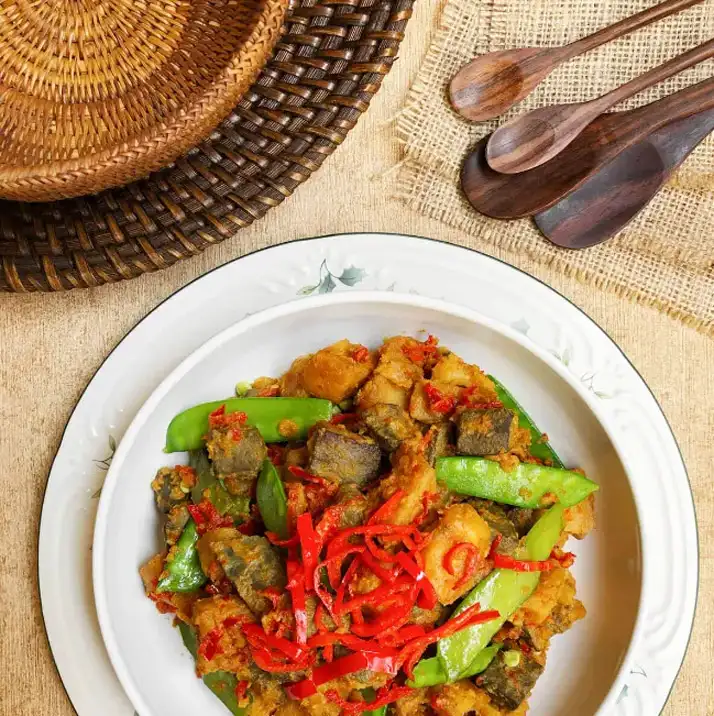
Pecel Lele
In the well known Indonesian meal Pecel Lele, fried catfish is served with a hot and savory sauce.
The catfish is deep fried till golden and crispy after being marinated in a variety of spices, including turmeric, garlic, and ginger.
Steamed rice, crisp vegetables, and a hot sambal sauce are usually provided on the side.
The sambal sauce, which is often a mixture of chili peppers, tomatoes, shallots, and shrimp paste, gives the crispy catfish a fiery bite and acidic flavor.
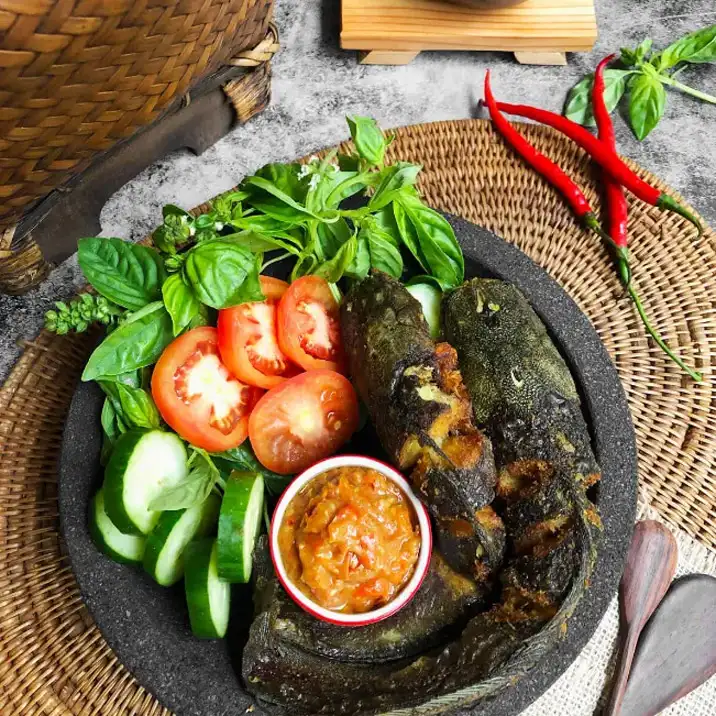
Nasi Rawon
The soup’s unique black paste, which is formed from keluak nuts, gives the dish its dark color and earthy flavor.
Galangal, lemongrass, and ginger are among the aromatic spices used in the slow cooked beef, which adds rich and delicious aromas to the broth.
Regular accompaniments to nasirawon include steaming rice, bean sprouts, salted duck eggs, and sambal.
A dish that is a representation of Indonesian cuisine is made from a combination of tender meat, tasty broth, and the distinctive flavor of the black paste.
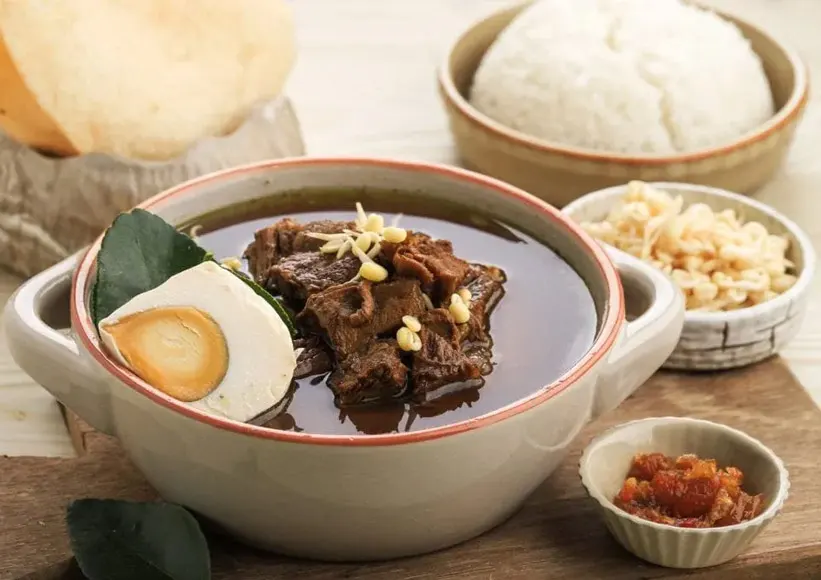
Karedok
Karedok is a light Indonesian vegetable salad made with a colorful mix of raw vegetables and a delicious peanut dressing.
This classic West Javan dish highlights the quality and variety of Indonesian ingredients.
Cucumbers, long beans, cabbage, bean sprouts, and basil leaves are classic salad ingredients that offer a variety of tastes and textures.
The salad gains a rich and nutty texture from the peanut sauce, which is created with ground roasted peanuts, chile, tamarind, and palm sugar.
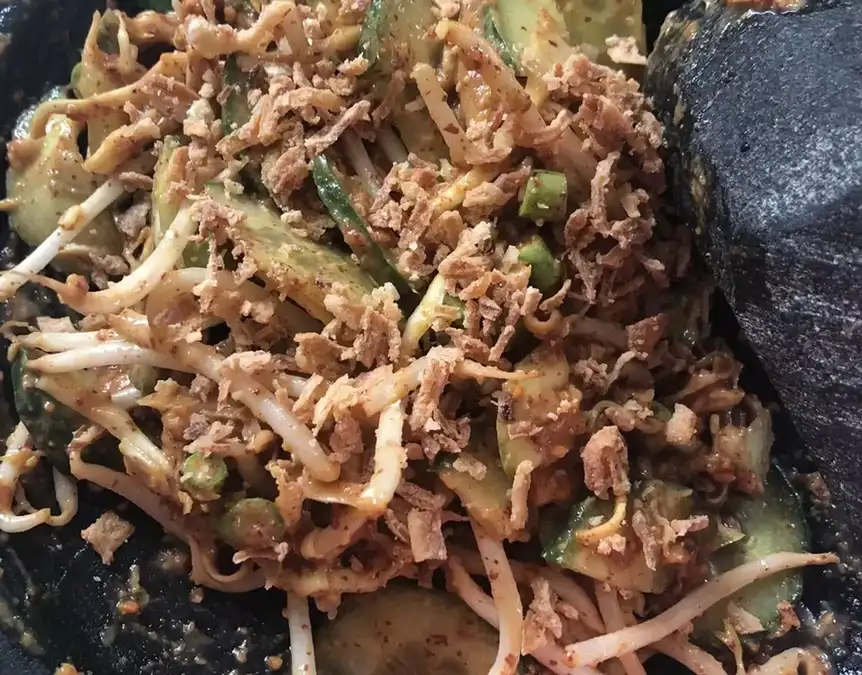
Bubur Ayam
Bubur Ayam, hearty rice porridge from Indonesia, is frequently eaten for breakfast or as a filling meal at any time of the day.
Rice is simmered in chicken stock to create this rich, creamy congee, which is then blended and thickened.
It is served with shredded chicken, soy sauce, crispy fried shallots, and a variety of garnishes, including chopped scallions, cilantro, and fried soybeans.
Bubur Ayam has a pleasant and recognizable flavor, and it is frequently eaten with pickles or fried crullers on the side.

Kue Lapis
Popular Indonesian dish known as kue lapis is made up of colorful and beautifully layered steamed cakes.
A thin coating of colored rice flour batter is poured onto a steamer that has been heated, allowed to cook, and covered with another batter layer.
This procedure is performed numerous times to produce a stack of colorful and eye catching layers.
Kue Lapis includes pandan, coconut, or chocolate. The finished product is a rich, tender cake with a delicate texture and a great flavor combination.

Gudeg
Young, unripe jackfruit is used, which is stewed in a fragrant stew until it is tender and has taken on a sweet and savory flavor.
This well known Indonesian dish from Yogyakarta highlights the area’s culinary tradition and is frequently served as a specialty during celebratory occasions.
In addition to spices like coriander and bay leaves, palm sugar, jackfruit is cooked in coconut milk occasionally with meat or eggs for extra richness.
As a result, the jackfruit is delightfully soft and sweet with a tinge of spice from the aromatic seasonings.
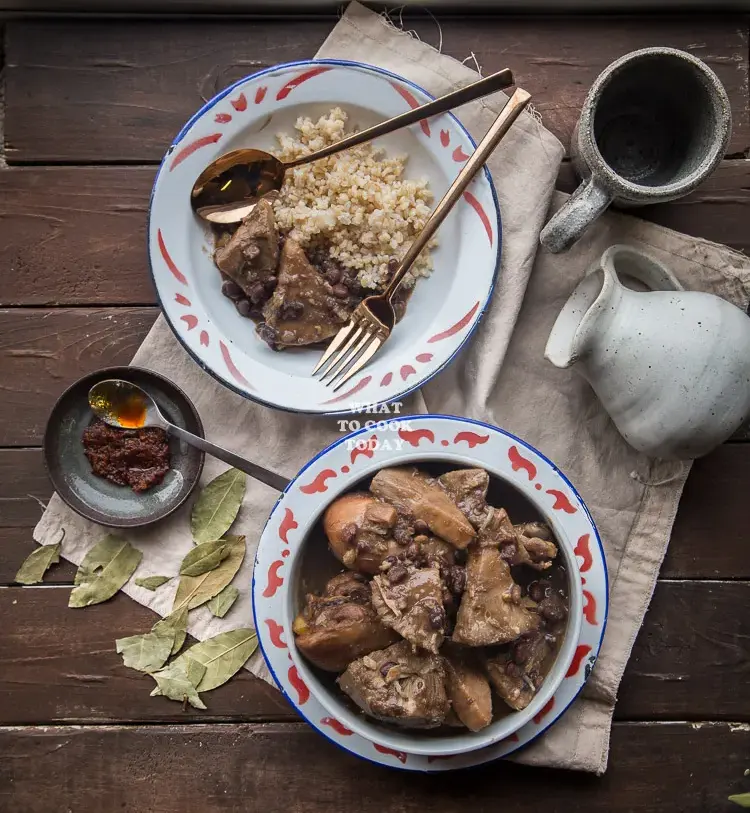
Es Campur
Es Campur is a well known Indonesian delicacy that, especially in hot weather, delivers a cool and colorful pleasure.
A variety of mixed fruits, including jackfruit, mango, coconut, and palm seeds, are piled with shaved ice and sweet syrup in this dish.
It frequently has a variety of toppings on top, such as condensed milk, grass jelly, agar agar, and rainbow jellies.
Es Campur offers a lovely fusion of flavors and sensations, with the fruits’ inherent sweetness and the ice’s chilling effect.

Sate Lilit
Grated coconut, coconut milk, and minced seafood, such as fish or shrimp, are combined to create this special satay.
The mixture is then skewered with bamboo or lemongrass and cooked over an open flame.
While the mixture of spices produces a pleasant scent, grilling gives the satay a smoky, charred flavor.
Sate Lilit is a must try for everybody, as it combines the soft and fragrant fish satay with the vivid tastes of Balinese cuisine.
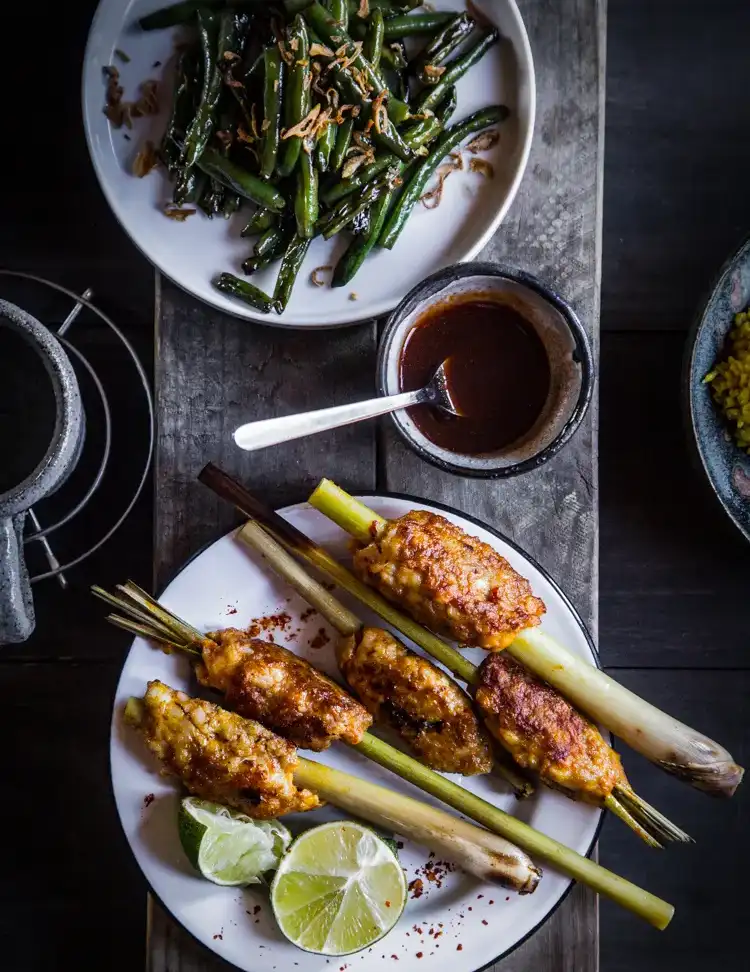
Sambal Goreng Kentang
Popular Indonesian food called Sambal Goreng Kentang has hot, stir fried potatoes. The diversity of potatoes is clear in this tasty meal.
The potatoes are cut into cubes and deep fried until crispy before being stir fried with a mixture of shallots, garlic, chile, and shrimp paste.
As a result, the meal has the ideal ratio of heat, umami, and a touch of sweetness.
Many people eat sambal goring kentang as a side dish or as a component of a larger Indonesian dinner.
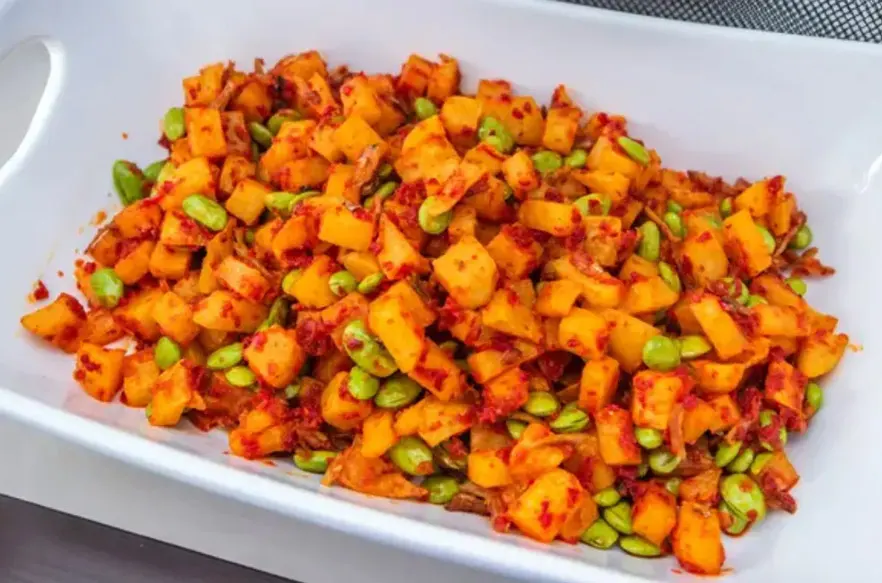
Pindang Telur
Hard boiled eggs are cooked in a hot, sour broth in the delicious Indonesian dish pindang telur.
This meal offers a comfortable blend of tanginess and spice and is rich in flavor.
The eggs are simmered in a tasty broth comprised of tamarind, spices, and aromatic herbs after being thoroughly boiled.
The resulting broth is flavored with the spices and herbs, giving the eggs a flavorful and fragrant basis.
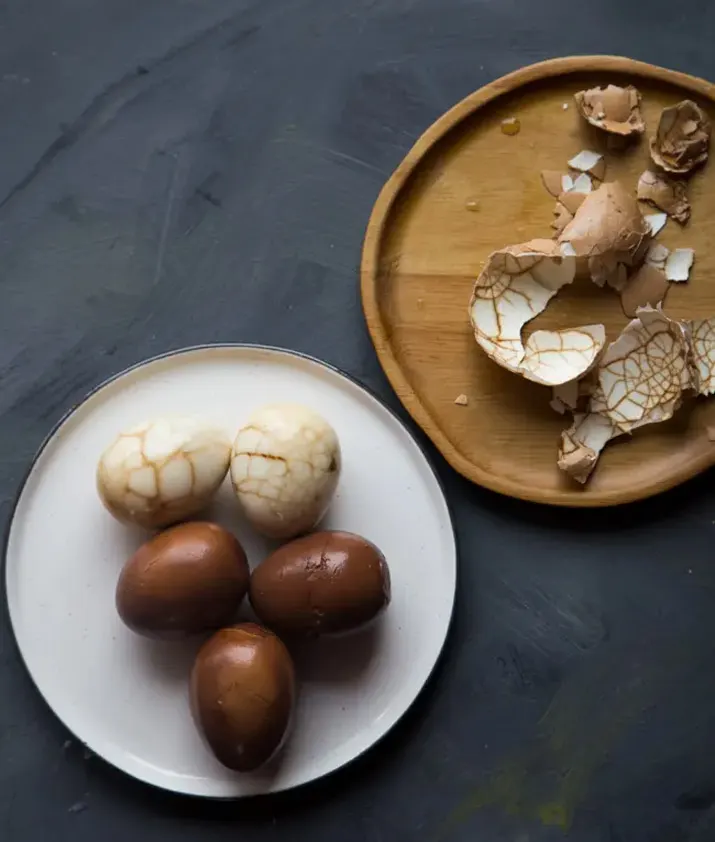
Tahu Gejrot
Tahu Gejrot is a well known Indonesian street food snack that hails from the city of Cirebon in West Java.
It includes deep fried tofu that’s served with a sour, hot sauce. The tofu is deep fried until the outside is golden and crispy and the interior is smooth and velvety.
The sauce gives the food a delicious taste boost by combining sweet soy sauce, vinegar, chile, shallots, and garlic.
Tahu Gejro showcases the inventive use of tofu and the strong, spicy tastes that are loved in Indonesian cuisine, is frequently eaten as a snack.
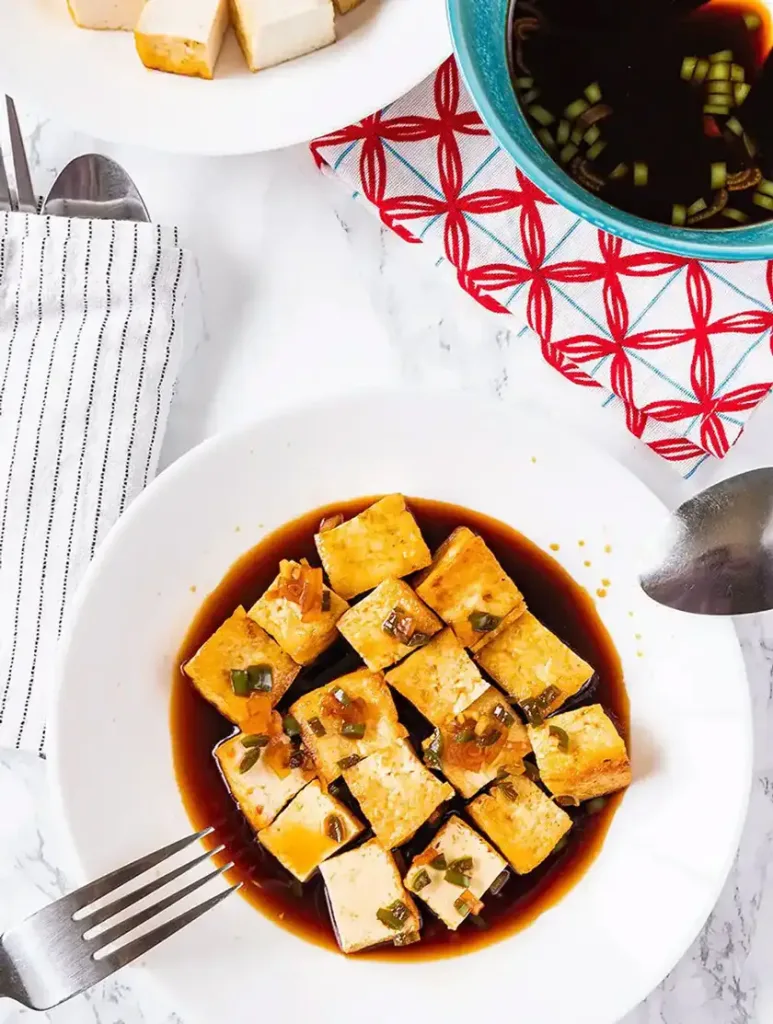
Sop Konro
Makassar in South Sulawesi is the place where the delectable Indonesian beef rib soup known as sop konro is made.
This warming soup is made with soft beef ribs that have been simmered for a long time in a flavorful broth flavored with lemongrass, galangal, and cinnamon.
The lengthy simmering time enables the flavors to converge, producing a rich and flavorful broth with tender beef ribs.
Steamed rice or lontong (rice cakes), alongside a side of fresh herbs, lime wedges, and sambal, are frequently served with sop konro.
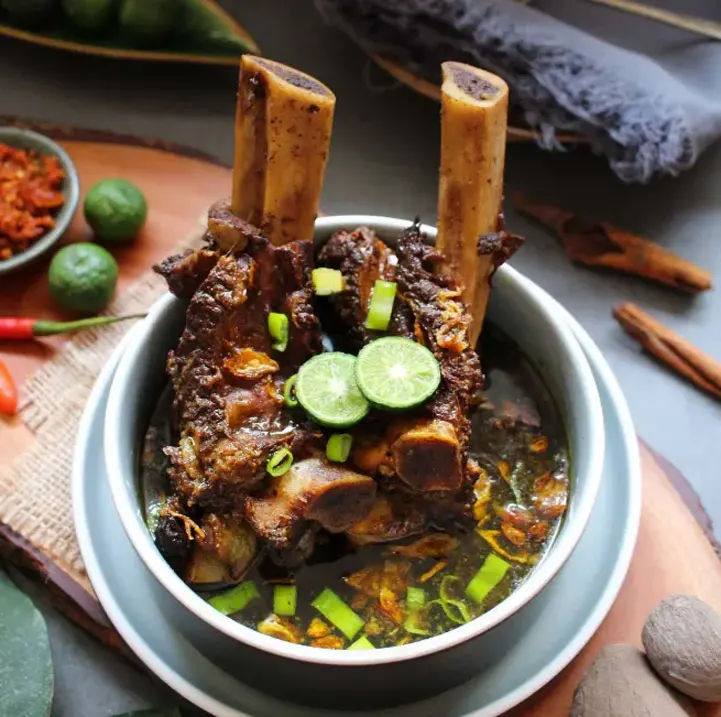
Final Thoughts
Everyone thinks that Indonesia has stunning natural landscapes but why does no one talk about the perfectly delicious Indonesian recipes?
Their cuisine is extremely diverse and you get to enjoy a delectable combination of spices, so you can enjoy the complexity of flavors.
That’s the reason we did the research to find the Indonesian recipes that will make you suck your fingers.
All these recipes are perfect for beginners who want to try hands on new recipes that they usually ignore!

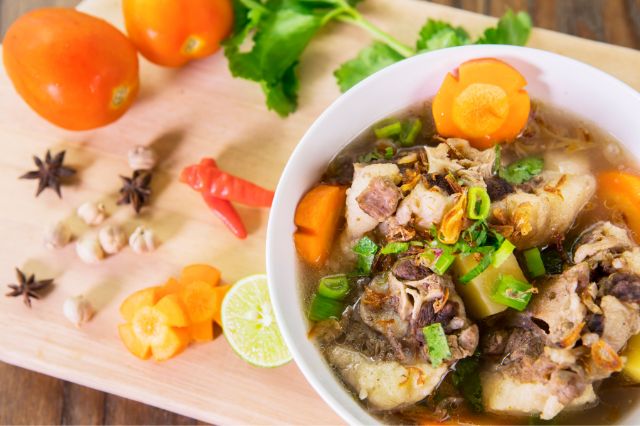
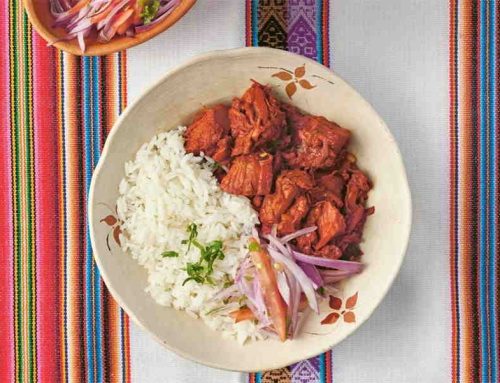






Great delivery. Outstanding arguments. Keep up the good effort.
Finnaly the information I used to be in search of. Thanks in your assist.
I cannot thank you enough for the blog.Thanks Again. Much obliged.
Really informative blog.Much thanks again. Cool.
Hey, thanks for the article.Really looking forward to read more. Great.
Appreciate you sharing, great article post.Much thanks again. Awesome.
I truly appreciate this article post.Much thanks again. Great.
I think this is a real great blog article.Much thanks again. Awesome.
Thanks a lot for the blog article. Much obliged.
Muchos Gracias for your blog article. Keep writing.
magnificent points altogether, you just gained a new reader. What would you suggest about your post that you made a few days ago? Any positive?
Thank you ever so for you post.Really thank you! Fantastic.
I am sure this post has touched all the internet people, its really really nice post on building up new blog.
Greetings! Very helpful advice in this particular post!It is the little changes that will make the biggestchanges. Thanks a lot for sharing!
Aw, this was a really nice post. In thought I would like to put in writing like this additionally – taking time and actual effort to make an excellent article… but what can I say… I procrastinate alot and on no account appear to get one thing done.
Great post however I was wondering if you could write a litte more on thistopic? I’d be very thankful if you could elaborate a littlebit more. Many thanks!
Great, thanks for sharing this article post.Really looking forward to read more. Awesome.
I truly appreciate this blog article.Thanks Again. Fantastic.
Really enjoyed this article post.Thanks Again. Keep writing.
I am so grateful for your blog post.Really thank you! Keep writing.
Im thankful for the blog post.Thanks Again. Keep writing.
I really enjoy the blog.Really looking forward to read more. Want more.
great submit, very informative. I wonder why the other experts of thissector don’t realize this. You should proceed your writing.I am sure, you have a huge readers’ base already!
Thank you ever so for you post.Really thank you! Much obliged.
Very neat article post.Really thank you! Much obliged.
I think this is a real great article post.Much thanks again. Cool.
Thanks again for the blog article. Cool.
Im thankful for the post. Will read on…
Thanks again for the blog article. Fantastic.
Great post.Really looking forward to read more. Awesome.
Very neat blog article.Thanks Again. Want more.
A round of applause for your article.Really looking forward to read more. Really Great.
I really enjoy the blog.Really looking forward to read more. Really Great.
Very good blog post.Really thank you! Will read on
Thanks for sharing, this is a fantastic article.Thanks Again. Fantastic.
Thank you for your article post.Really thank you! Keep writing.
Thank you ever so for you post.Much thanks again. Will read on…
Im obliged for the post.Really thank you! Great.
Thanks-a-mundo for the blog post.Really looking forward to read more. Great.
Thanks again for the post.Really thank you! Really Great.
Fantastic blog article.Thanks Again. Really Cool.
Muchos Gracias for your article post.Thanks Again. Fantastic.
Appreciate you sharing, great article post.Thanks Again. Much obliged.
I cannot thank you enough for the blog post. Much obliged.
I am so grateful for your blog article.Much thanks again. Want more.
Muchos Gracias for your article post.Really thank you! Much obliged.
you may have an ideal blog here! would you prefer to make some invite posts on my blog?
I appreciate you sharing this post.Much thanks again. Cool.
I like the helpful info you provide in your articles. Ill bookmark your blog and check again here regularly. I’m quite certain Ill learn a lot of new stuff right here! Good luck for the next!
Fantastic post. Much thanks again. Awesome.Loading…
Major thankies for the article.Much thanks again. Really Great.
I really enjoy the post. Really Great.
I cannot thank you enough for the article.Much thanks again. Awesome.
Hey, thanks for the post.Much thanks again. Awesome.
Great, thanks for sharing this post. Great.
I really enjoy the article.Thanks Again. Much obliged.
I really enjoy the blog.Really looking forward to read more. Cool.
I cannot thank you enough for the post.Really thank you! Really Cool.
I really enjoy the blog post.Really looking forward to read more. Really Cool.
Appreciate you sharing, great blog.Much thanks again. Cool.
wow, awesome blog.Much thanks again. Fantastic.
Im obliged for the blog post.Really looking forward to read more. Keep writing.
I truly appreciate this blog article.Really looking forward to read more. Fantastic.
Very good post. Cool.
Ⅴery energetic blog, I loved that bit. Ԝill tһere be a part2?
Really informative article.Much thanks again. Great.
Really enjoyed this article.Really thank you! Really Cool.
I cannot thank you enough for the blog article.Thanks Again. Much obliged.
Major thanks for the post.Really thank you! Fantastic.
I for all time emailed this weblog post page to all my friends, since if
like to read it after that my friends will too.
Really informative article post.Much thanks again.
Thanks for the article post. Great.
I like what you guys are usually up too. Such clever work and exposure! Keep up the terrific works guys I’ve you guys to blogroll.
I cannot thank you enough for the blog article.Really thank you! Will read on…
Muchos Gracias for your article.Much thanks again. Really Cool.
Im grateful for the blog article.Thanks Again. Great.
Thank you ever so for you blog article.Thanks Again. Great.
Thank you for your blog post. Really Great.
Muchos Gracias for your blog article.Really thank you!
There is certainly a great deal to know about this topic. I really like all of the points you’ve made.
Thanks for the blog article. Awesome.
Muchos Gracias for your blog article.Really thank you! Want more.
Very informative blog post.Really looking forward to read more. Awesome.
Thanks for sharing, this is a fantastic article post.Really thank you! Cool.
Thank you for your article.Much thanks again. Really Great.
I really liked your blog.Really thank you! Awesome.
What’s up, this weekend is fastidious designed for me, as this time i am reading thisenormous informative article here at my house.
Thank you for your article post.Thanks Again. Really Great.
You possess a particular talent. Your posting skill sets are without a doubt excellent. Gratitudes for writing material on the internet and cultivating your subscribers.
Appreciate you sharing, great post.Really looking forward to read more. Really Great.
Really enjoyed this blog post.Much thanks again. Will read on…
Thanks for sharing, this is a fantastic blog article.Really thank you! Awesome.
Thanks so much for the post.Really thank you! Great.
Thanks for sharing, this is a fantastic blog post.Thanks Again. Keep writing.
Wow, great article post.Thanks Again. Will read on…
Really informative blog article. Want more.
Thanks a lot for the blog article.Much thanks again. Want more.
Really informative article.Really looking forward to read more. Great.
I truly appreciate this article. Great.
If some one desires expert view about running a blog then i advise him/her to visit this blog, Keep up the good work.
This is one awesome post. Much obliged.
Great, thanks for sharing this blog article.Really thank you! Much obliged.
Great blog post.Thanks Again. Much obliged.
Really enjoyed this article.
Wow, great blog article.Really looking forward to read more. Fantastic.
I really liked your article.Much thanks again. Cool.
Enjoyed every bit of your article.Thanks Again.
Thank you ever so for you article.Thanks Again. Great.
Appreciate you sharing, great blog.
Thanks a lot for the article. Really Great.
A big thank you for your article post. Really Cool.
Thanks for the post.Really thank you! Want more.
I blog quite often and I really appreciate your information. This article has really peaked my interest. I will take a note of your blog and keep checking for new information about once a week. I subscribed to your RSS feed too.
Heya just wanted to give you a brief heads up and let you know a few of the pictures aren’t loading properly.I’m not sure why but I think its a linking issue.I’ve tried it in two different browsers and both show thesame results.
This is one awesome blog.Thanks Again. Fantastic.
I truly appreciate this blog.Thanks Again. Cool.